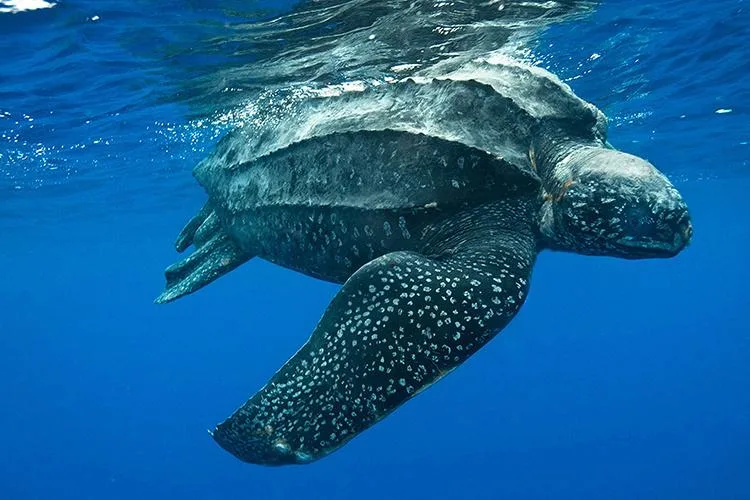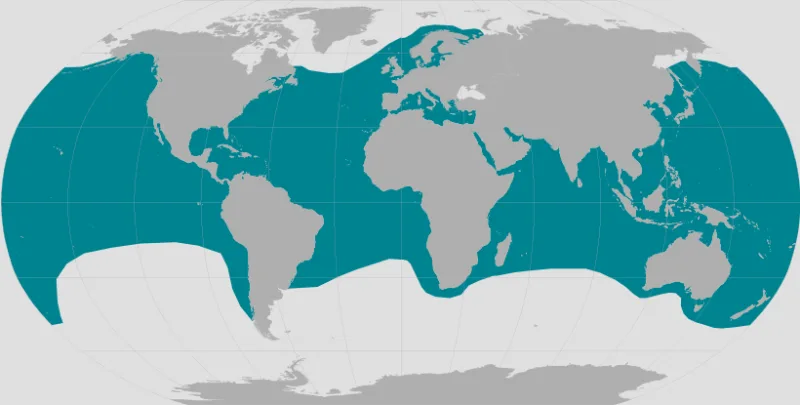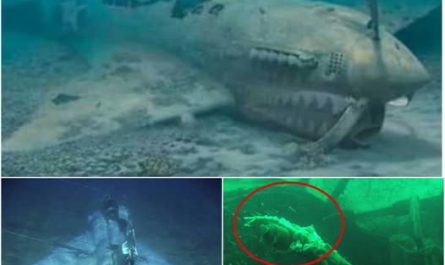About the Species
The leatherback sea turtle is the largest turtle in the world. They are the only species of sea turtle that lack scales and a hard shell. They are named for their tough rubbery skin and have existed in their current form since the age of the dinosaurs. Leatherbacks are highly migratory, some swimming over 10,000 miles a year between nesting and foraging grounds. They are also accomplished divers with the deepest recorded dive reaching nearly 4,000 feet—deeper than most marine mammals.

The leatherback turtle has the widest global distribution of any reptile, with nesting mainly on tropical or subtropical beaches. Once prevalent in every ocean except the Arctic and Antarctic, the leatherback population is rapidly declining in many parts of the world. They face threats on both nesting beaches and in the marine environment. The greatest of these threats worldwide are incidental capture in fishing gear (bycatch), hunting of turtles, and collection of eggs for human consumption. The Pacific leatherback turtle populations are most at-risk of extinction. Pacific leatherbacks are one of nine ESA-listed species identified in NOAA’s Species in the Spotlight initiative. Through this initiative, NOAA Fisheries has made it a priority to focus recovery efforts on stabilizing and recovering Pacific leatherback populations in order to prevent their extinction.
NOAA Fisheries and our partners are dedicated to conserving and recovering leatherback turtle populations worldwide. We use a variety of innovative techniques to study, protect, and recover this endangered species. We engage our partners as we develop regulations and implement recovery plans that foster the conservation and recovery of leatherbacks and their habitats, and we fund research, monitoring, and conservation projects to implement priorities outlined in recovery plans.
Population Status
The leatherback sea turtle is listed as endangered under the Endangered Species Act. It is estimated that the global population has declined 40 percent over the past three generations. Leatherback nesting in Malaysia has essentially disappeared, declining from about 10,000 nests in 1953 to less than one or two nests per year since 2003.
The Pacific leatherback turtle populations are most at-risk for extinction as evidenced by ongoing precipitous declines in nesting through their range. Primary nesting habitats of the Eastern Pacific leatherback turtle population are in Mexico and Costa Rica, with some isolated nesting in Panama and Nicaragua. Over the last three generations, nesting in this region has declined by over 90 percent. In the Western Pacific, primary nesting habitats are in Indonesia, Papua New Guinea and the Solomon Islands. The largest remaining nesting population, which accounts for 50-75 percent of the Western Pacific population, occurs in Papua Barat, Indonesia and has also declined by over 80 percent.
In the Northwest Atlantic, leatherback nesting was increasing; however, there have been significant decreases in recent years at numerous locations, including on the Atlantic coast of Florida, which is one of the main nesting areas in the continental United States. Large but potentially declining nesting populations also occur in the eastern Atlantic, along the west African coastline, but uncertainty in the data limits our understanding of the trends at many of those nesting beaches.
The 2020 Status Review of the leatherback sea turtle under the ESA provides additional information on abundance and population trends.
Appearance
The leatherback has a primarily black, rubbery skin with pinkish-white coloring on its underside. They are the only species of sea turtle that lack scales. Their shell (carapace) consists of small, interlocking dermal bones beneath the skin that overlie a supportive layer of connective tissue and fat and the deeper skeleton. Their carapace has seven ridges along its length and tapers to a blunt point. Their front flippers are proportionally longer than in other sea turtles and their back flippers are paddle-shaped. Both their rigid carapace and their large flippers make the leatherback uniquely equipped for long distance foraging migrations.
Behavior and Diet
Leatherback sea turtles undertake the longest migrations between breeding and feeding areas of any sea turtle, some averaging 3,700 miles each way. They spend most of their lives in the ocean, but females leave the water to lay eggs. Leatherbacks are strong swimmers and can dive to depths of approximately 4,000 feet—deeper than any other turtle—and can stay down for up to 85 minutes.
Leatherbacks lack the crushing, beak characteristic of other sea turtles that feed on hard-bodied prey. Instead, they have pointed tooth-like cusps and sharp-edged jaws that are perfectly adapted for a diet of soft-bodied open ocean prey such as jellyfish and salps. A leatherback’s mouth and throat also have backward-pointing spines that help retain gelatinous prey.
Where They Live
Leatherbacks occur in the Atlantic, Pacific, and Indian Oceans. Nesting beaches are primarily located in tropical latitudes around the world. Globally, the largest remaining nesting aggregations are found in Trinidad and Tobago, West-Indies (Northwest Atlantic) and Gabon, Africa (Southeast Atlantic).
Leatherbacks occupy U.S. waters in the Northwest Atlantic, West Pacific, and East Pacific. Within the United States, the majority of nesting occurs in Florida, Puerto Rico, and the U.S. Virgin Islands. Leatherbacks have been satellite tagged at sea on foraging grounds off Nova Scotia, Canada and tracked to nesting beaches in the Caribbean. Western Pacific leatherbacks feed off the Pacific coast of North America, and migrate across the Pacific to nest in Indonesia, Papua New Guinea, and the Solomon Islands. Eastern Pacific leatherbacks, on the other hand, nest along the Pacific coast of Mexico and Costa Rica, and forage in the south-central and eastern tropical Pacific Ocean.

Lifespan & Reproduction
Leatherback turtles grow faster than hard-shelled turtles. However, there is uncertainty about the age at which they reach sexual maturity. Average estimates range from 9 to 20 years of age. Likewise, little is known about their life expectancy, but they are likely long-lived, with longevity estimates of 45 to 50 years, or more.
Female leatherbacks nest at night on tropical and subtropical beaches. They dig a large body pit to lay their eggs in deep egg chambers/nests. A nesting leatherback will disturb a huge area on the beach and leave behind long, circling tracks. In the United States and Caribbean, the nesting season lasts from March to July. Satellite tagging studies of leatherbacks from the Western Pacific indicate that turtles that nest during different times of the year have different migration patterns. Summer nesting turtles (July through September) have tropical and temperate northern hemisphere foraging regions, while winter nesters (November through February) traverse to tropical waters and temperate regions of the southern hemisphere. Female leatherbacks return to nest every 2 to 4 years. Leatherbacks nest several times during a nesting season, typically at 8- to 12-day intervals and lay clutches of approximately 100 eggs. The eggs incubate approximately two months before leatherback hatchlings emerge from the nest.
Threats
Bycatch in Fishing Gear
The primary threat to leatherback turtles is their unintended capture in fishing gear which can result in drowning or cause injuries that lead to death or debilitation (for example, swallowing hooks or flipper entanglement). The term for this unintended capture is bycatch. Sea turtle bycatch is a worldwide problem. The primary types of gear that result in bycatch of leatherback turtles include gillnets, trawls, longlines, and vertical buoy lines attached to pot/traps.
Direct Harvest of Turtles and Eggs
Historically, leatherbacks were killed for their meat and their eggs were collected for consumption and sale. Presently, leatherback turtles are protected in many countries, but in some places, the hunting of leatherbacks and collection and consumption of eggs continue.
Loss and Degradation of Nesting Habitat
Coastal development and rising seas from changing environmental conditions are leading to the loss of nesting beach habitat for leatherback turtles. Human-related changes associated with coastal development include beachfront lighting, shoreline armoring, and beach driving. Shoreline hardening or armoring (e.g., sea walls) can result in the complete loss of dry sand suitable for successful nesting. Artificial lighting on and near nesting beaches can deter nesting females from coming ashore to nest and can disorient hatchlings trying to find the sea after emerging from their nests.
Vessel Strikes
Various types of watercraft can strike leatherback turtles when they are at or near the surface, resulting in injury or death. Vessel strikes are a major threat near ports and waterways, and adjacent to highly developed coastlines. Adult sea turtles, in particular nesting females, are more susceptible to vessel strikes when making reproductive migrations and while they are nearshore during the nesting season. Vessel strikes are a significant cause of leatherback strandings in the eastern United States.
Ocean Pollution/Marine Debris
Increasing pollution of nearshore and offshore marine habitats threatens all sea turtles and degrades their habitats. Ingestion of marine debris is another threat to all species of sea turtles. Leatherback turtles may ingest fishing line, balloons, plastic bags, plastic fragments, floating tar or oil, and other materials discarded by humans which they can mistake for food. They may also become entangled in marine debris, including lost or discarded fishing gear, which can lead to injury or death.
Changing Environmental Conditions
For all sea turtles, higher sand temperatures can be lethal to eggs, or alter the ratio of male and female hatchlings produced (via temperature-dependent sex determination). Rising seas and storm events change beach morphology, causing beach erosion which may flood nests or wash them away. Changes in the temperature of the marine environment are likely to alter habitat suitability, as well as the abundance and distribution of food resources, leading to a shift in the migratory and foraging range and nesting season of leatherbacks.
Source: fisheries.noaa.gov





